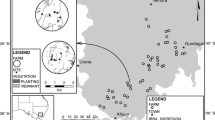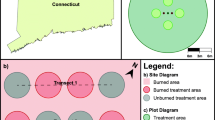Abstract
With the advent of modern sanitary landfill closure techniques, the opportunity exists for transforming municipal landfills into urban woodlands. While costs of fullscale reforestation are generally prohibitive, a modest planting of clusters of trees and shrubs could initiate or accelerate population expansions and natural plant succession from open field to diverse forest. However, among woody species that have been screened for use on landfills, these ecological potentials have not yet been investigated. We examined a 14-yr-old landfill plantation in New Jersey, USA, established to test tolerance of 19 species of trees and shrubs to landfill environments. We measured survivorship, reproduction, and recruitment within and around the experimental installation. Half of the original 190 plants were present, although survival and growth rates varied widely among species. An additional 752 trees and shrubs had colonized the plantation and its perimeter, as well as 2955 stems of vines. However, the great majority (>95%) of woody plants that had colonized were not progeny of the planted cohort, but instead belonged to 18 invading species, mostly native, bird-dispersed, and associated with intermediate stages of secondary plant succession. Based on this evidence, we recommend that several ecological criteria be applied to choices of woody species for the restoration of municipal landfills and similar degraded sites, in order to maximize rapid and economical establishment of diverse, productive woodlands.
Similar content being viewed by others
Literature Cited
Arthur, J. J., I. A. Leone, and F. B. Flower. 1981. Flooding and landfill gas effects on red and sugar maples.Journal of Environmental Quality 10:431–433.
AuClair, A. N., and G. Cottam. 1971. Dynamics of black cherry (Prunus serotina) in southern Wisconsin oak forests.Ecological Monographs 41:153–177.
Bradshaw, A. D., and M. J. Chadwick. 1980. The restoration of land. University of California Press, Berkeley, California, 317 pp.
Buckley, G. P. (ed.). 1989. Biological habitat reconstruction. Belhaven Press, London, 363 pp.
Brown, D., R. G. Hallman, C. R. Lee, J. G. Skogerboe, K. Eskew, R. A. Price, N. R. Page, M. Clar, R. Kort, and H. Hopkins. 1986. Reclamation and vegetation restoration of problem soils and disturbed lands. Noyes Data Corporation, Park Ridge, New Jersey, 560 pp.
Ettala, M. O. 1987. Influence of irrigation with leachate on biomass production and evapotranspiration on a sanitary landfill.Aqua Fennica 17:69–86.
Ettala, M. O. 1988. Short-rotation tree plantations at sanitary landfills.Waste Management and Research 6:291–302.
Finegan, B. 1984. Forest succession.Nature 312:109–114.
Flower, F. B., I. D. Leone, E. F. Gilman, and J. J. Arthur. 1978. A study of vegetation problems associated with refuse landfills. US Environmental Protection Agency Publication 600/2-78-094.
Gilman, E. F. 1979. Screening of woody species and planting techniques for suitability in vegetating completed sanitary refuse landfills. Master's thesis. Graduate Program in Plant Pathology, Rutgers University, New Brunswick, New Jersey.
Gilman, E. F. 1980. Determining the adaptability of woody species, planting techniques and the critical factors for revegetating completed refuse landfill sites. Doctoral thesis. Graduate Program in Plant Pathology, Rutgers University, New Brunswick, New Jersey.
Gilman, E. F., Flower, F. B., and Leone, I. D. 1985. Standardized procedures for planting vegetation on completed landfills.Waste Management and Research 3:65–80.
Johnston, D. W., and E. P. Odum. 1956. Breeding bird populations on relation to plant succession on the Piedmont of Georgia.Ecology 37:50–62.
Leone, I. D., F. B. Flower, E. F. Gilman, and J. J. Arthur. 1979. Adapting woody species and planting techniques to landfill conditions. US Environmental Protection Agency Publication 600/2-79-128.
Lutton, R. J. 1982. Evaluating cover systems for solid and hazardous waste. US Environmental Protection Agency, Office of Solid Waste and Emergency Response, Manual SW-867 (revised).
Malcom, C. V. 1990. Rehabilitation agronomy—guidelines for revegetating degraded land.Proceedings of the Ecological Society of Australia 16:551–556.
McAtee, W. L. 1947. Distribution of seeds by birds.American Midland Naturalist 38:214–223.
McDonnell, M. J. 1986. Old field vegetation height and the dispersal pattern of bird-disseminated woody plants.Bulletin of the Torrey Botanical Club 113:6–11.
McDonnell, M. J., and E. W. Stiles. 1983. The structural complexity of old-field vegetation and the recruitment of bird-dispersed plant species.Oecologia 56:109–116.
O'Leary, P. R., P. W. Walsh, and R. K. Ham. 1988. Managing solid waste.Scientific American 259:36–42.
Oosting, H. J. 1956. The study of plant communities, 2nd ed. Freeman, San Francisco, California, 440 pp.
Smith A. J. 1975. Invasion and ecesis of bird-disseminated woody plants in a temperate forest sere.Ecology 56:19–34.
Stalter, R. 1984. The plant communities on four landfill sites, New York City, New York.Proceedings of the Annual Meetings, Northeastern Weed Science Society 38:64–71.
USDA (US Department of Agriculture). 1948. Woody plant seed manual. Miscellaneous publication 654. US Government Printing Office, Washington, DC, p. 300.
US EPA (US Environmental Protection Agency). 1980a. Classifying solid waste disposal facilities. Office of Water and Waste Management, Manual SW-828. US Government Printing Office, Washington, DC.
US EPA (US Environmental Protection Agency). 1980b. Lining of waste impoundment and disposal facilities. Office of Water and Waste Management, Manual SW-870. US Government Printing Office, Washington, DC.
Wathern, P. 1986. Restoring derelict lands in Great Britain. Pages 248–274in Committee on the Applications of Ecological Theory to Environmental Problems (eds.), Ecological knowledge and environmental problem solving. National Academy Press, Washington, DC.
Whittaker, R. H. 1975. Communities and Ecosystems, 2nd ed. Macmillan, New York, 385 pp.
Author information
Authors and Affiliations
Rights and permissions
About this article
Cite this article
Robinson, G.R., Handel, S.N. & Schmalhofer, V.R. Survival, reproduction, and recruitment of woody plants after 14 years on a reforested landfill. Environmental Management 16, 265–271 (1992). https://doi.org/10.1007/BF02393832
Issue Date:
DOI: https://doi.org/10.1007/BF02393832




